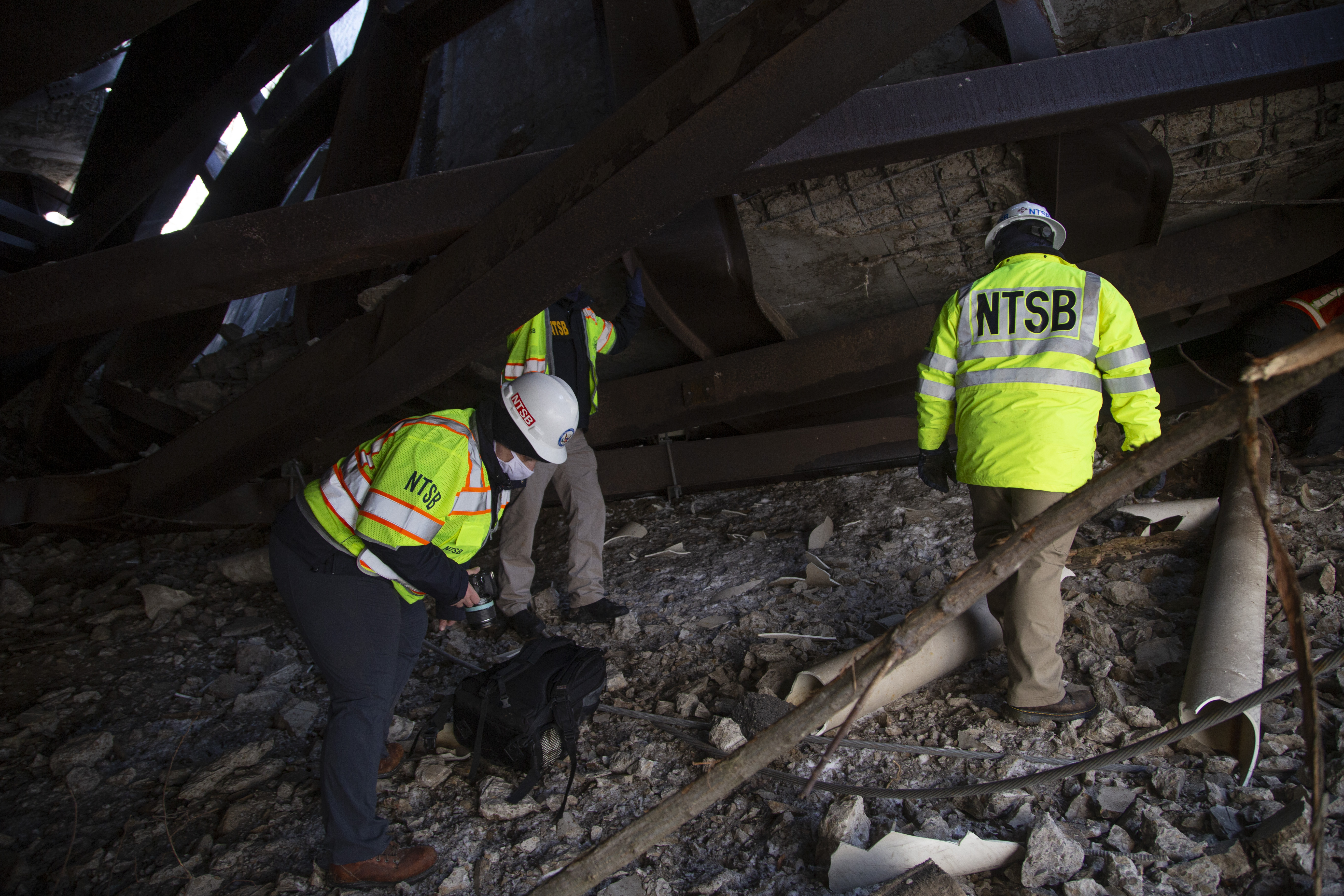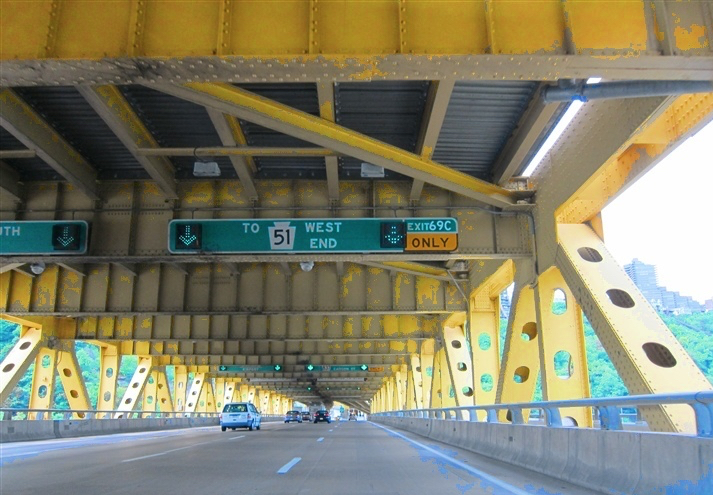|
George S. Richardson (engineer)
George Sherwood Richardson (1896–1988) was an American engineer known for his elegant bridges, innovative construction techniques and skillful planning of highways. Designer of many bridges in the Pittsburgh and Allegheny County areas in the 20th century, he has been called "the dean of Pittsburgh bridge engineers". Early life and education Born in Georgetown, Colorado, he served in World War I prior to graduating from the University of Colorado in 1920. Engineering career After a stint with the Wyoming Department of Highways and time on the faculty of the University of Pennsylvania, Richardson moved to Pittsburgh in 1922 to work for the American Bridge Company before he joined the Allegheny County Department of Public Works in 1924, where he went on to rise to be assistant chief engineer by the time he left in 1937. Richardson, Gordon & Associates In 1939 he founded his own firm, as George S. Richardson, Consulting Engineer; after taking on partners, the firm was renamed to ... [...More Info...] [...Related Items...] OR: [Wikipedia] [Google] [Baidu] |
Georgetown, Colorado
Georgetown is the List of municipalities in Colorado#Territorial charter municipality, territorial charter municipality that is the county seat of Clear Creek County, Colorado, Clear Creek County, Colorado, United States. The town population was 1,118 at the 2020 United States census. The former silver mining camp along Clear Creek (Colorado), Clear Creek in the Front Range of the Rocky Mountains was established in 1859 during the Pike's Peak Gold Rush. The federally designated Georgetown-Silver Plume Historic District comprises Georgetown, the neighboring town of Silver Plume, Colorado, Silver Plume, and the Georgetown Loop Railroad, Georgetown Loop Historic Mining & Railroad Park between the two towns. The Georgetown United States Postal Service, Post Office has the ZIP code 80444. The town sits at an elevation of above sea level, nestled in the mountains near the upper end of the valley of Clear Creek in the mountains west of Denver along Interstate 70 in Colorado, I-70. Alth ... [...More Info...] [...Related Items...] OR: [Wikipedia] [Google] [Baidu] |
West End Bridge (Pittsburgh)
The West End Bridge is a steel tied-arch bridge over the Ohio River in Pittsburgh, Pennsylvania, approximately below the confluence of the Allegheny and Monongahela Rivers. It connects the West End to the Chateau neighborhood on the North Side of Pittsburgh. The bridge was built from 1930 to 1932 primarily by the American Bridge Company (superstructure) and the Foundation Company (substructure). The bridge was designed by George S. Richardson. It was the longest tied-arch bridge in the world when completed, and just the second bridge to use tied-arch technology over a long span, after the Tacony–Palmyra Bridge (1929) in Philadelphia. The bridge was placed on the National Register of Historic Places in 1979 and the List of Pittsburgh History and Landmarks Foundation Historic Landmarks in 2001. As of 2016, the bridge and its surrounding approaches are undergoing some major reconstruction. The Riverlife Task Force conducted a competition in the spring of 2006 to design a ... [...More Info...] [...Related Items...] OR: [Wikipedia] [Google] [Baidu] |
Society Of American Military Engineers
The Society of American Military Engineers (SAME) unites public and private sector individuals and organizations from across the architecture, engineering, construction, environmental, facility management, contracting and acquisition fields and related disciplines in support of the United States' national security. SAME connects architects, engineers and builders in the public sector and private industry, uniting them to improve individual and collective capabilities to provide the capability and prepare for and overcome natural and man-made disasters, acts of terrorism and to improve security at home and abroad. That goal grew from America's experiences in World War I in which more than 11,000 civilian engineers were called to duty upon the United States entering the conflict. Returning home after "the war to end war," many feared the sector would lose this collective knowledge and the cooperation between public and private sectors that proved vital to combat success. Industry ... [...More Info...] [...Related Items...] OR: [Wikipedia] [Google] [Baidu] |
National Society Of Professional Engineers
The National Society of Professional Engineers (abbreviate as NSPE) is a professional association representing licensed professional engineers in the United States. NSPE is the recognized voice and advocate of licensed Professional Engineers represented in 53 state and territorial societies and over 500 local chapters. The society is based in Alexandria, Virginia. History The society was founded in 1934 as a nontechnical organization for licensed professional engineers. The bridge engineer David B. Steinman was its first president and one of the group of professional engineers that established it. NSPE published ''Canons of Ethics for Engineers and Rules of Professional Conduct'' in 1946, which evolved to the current ''Code of Ethics'' adopted in 1964. The first fundamental canon is "Hold paramount the safety, health and welfare of the public." In 1973, NSPE entered into an agreement with the Society of Women Engineers to support efforts to increase the number of women profess ... [...More Info...] [...Related Items...] OR: [Wikipedia] [Google] [Baidu] |
American Road And Transportation Builders Association
The American Road & Transportation Builders Association (ARTBA) is a trade association representing the transportation construction industry in the United States and is based in Washington, D.C., United States. Established in 1902, the association has more than 8,000 members from the public and private sectors and advocates for investment in transportation infrastructure. The United States transportation construction industry generates more than $580 billion in annual economic activity and supports more than 4 million American jobs. ARTBA membership divisions include contractors, planning and design, transportation officials, traffic safety, materials and services, public-private partnerships, research and education, and equipment manufacturers. ARTBA's members have knowledge and experience in building the road, rail, air, port, and waterway facilities of the United States. Function ARTBA is a federation whose primary goal is to bring together all facets of the transportation ... [...More Info...] [...Related Items...] OR: [Wikipedia] [Google] [Baidu] |
American Council Of Engineering Companies
The American Council of Engineering Companies (ACEC) is the oldest and largest business association of engineering companies. It is organized as a federation of 52 state and regional councils with national headquarters in Washington, D.C., comprising thousands of engineering practices throughout the country. It administers extensive lobbying and education programs. History ACEC traces its roots to the Association of Architectural Engineers, founded in New York City in 1905 to promote the business interests of consulting engineers. The organization, which was based on individual memberships, changed its name to the American Institute of Consulting Engineers (AICE) in 1909. Similar organizations soon sprung up in many states. In 1930, notable member Blake R. Van Leer lobbied congress for a National Museum of Engineering and Industry. In 1956, representatives from 10 state associations created a national Consulting Engineers Council (CEC), representing engineering firms rather than ... [...More Info...] [...Related Items...] OR: [Wikipedia] [Google] [Baidu] |
American Society Of Civil Engineers
The American Society of Civil Engineers (ASCE) is a tax-exempt professional body founded in 1852 to represent members of the civil engineering profession worldwide. Headquartered in Reston, Virginia, it is the oldest national engineering society in the United States. Its constitution was based on the older Boston Society of Civil Engineers from 1848. ASCE is dedicated to the advancement of the science and profession of civil engineering and the enhancement of human welfare through the activities of society members. It has more than 143,000 members in 177 countries. Its mission is to provide essential value to members, their careers, partners, and the public; facilitate the advancement of technology; encourage and provide the tools for lifelong learning; promote professionalism and the profession; develop and support civil engineers. History The first serious and documented attempts to organize civil engineers as a professional society in the newly created United States were ... [...More Info...] [...Related Items...] OR: [Wikipedia] [Google] [Baidu] |
Fern Hollow Bridge
The Fern Hollow Bridge is a bridge in the East End (Pittsburgh), East End of Pittsburgh, Pennsylvania, United States, that carries Forbes Avenue over a large ravine in Frick Park. The current bridge is the third on the site. The first Fern Hollow Bridge opened in 1901 as a steel deck arch, and was demolished in 1972 while the second bridge was being built. The second bridge opened in 1973 and collapsed on January 28, 2022. Construction of the third bridge began on May 9, 2022, and the third bridge was dedicated on December 20, 2022. The bridge lies west of the intersection of Forbes Avenue and South Braddock Avenue, connecting the Squirrel Hill (Pittsburgh), Squirrel Hill neighborhood with the neighborhoods of Point Breeze, Pittsburgh, Point Breeze and Regent Square (Pittsburgh), Regent Square. First bridge (1901–1972) In February 1900, the "Councils of the city of Pittsburg" appropriated United States dollar, $100,000 for the construction of a street railway and highway brid ... [...More Info...] [...Related Items...] OR: [Wikipedia] [Google] [Baidu] |
Fort Duquesne Bridge
The Fort Duquesne Bridge is a steel bowstring arch bridge that spans the Allegheny River in Pittsburgh, Pennsylvania. It was colloquially referred to as " The Bridge to Nowhere" prior to its completion. History The bridge was constructed from 1958-1963 by PennDOT, and opened for traffic on October 17, 1969, with its predecessor Manchester Bridge (located closer to the tip of Point State Park) closing that same day (it was demolished in the autumn of 1970). The bridge was named "The Bridge to Nowhere" because the main span was finished in 1963, but due to delays in acquiring the right of way for the northern approach ramps, it did not connect on the north side of the Allegheny River. The total cost was budgeted at $5 million in 1962. The lack of approach ramps meant the bridge ended in midair, rendering it useless. On December 12, 1964, Frederick Williams, a 21-year-old chemistry major at the University of Pittsburgh from Basking Ridge, New Jersey, drove his 1959 Chrysler s ... [...More Info...] [...Related Items...] OR: [Wikipedia] [Google] [Baidu] |
Fort Pitt Bridge
The Fort Pitt Bridge is a steel, double-decked bowstring arch bridge that spans the Monongahela River near its confluence with the Allegheny River in Pittsburgh, Pennsylvania. It carries Interstate 376 between the Fort Pitt Tunnel and Downtown Pittsburgh. Opened in June 1959 as a replacement for the Point Bridge, the Fort Pitt Bridge was the world's first computer-designed bowstring arch bridge and double-decked bowstring arch bridge. The bridge is known for its difficult lane changes, especially on the lower level, often requiring people to go from the extreme left lane across two lanes to the extreme right lane in only 700 feet. The upper level is more forgiving for some routes but still requires a full span lane change in 700 feet to get from the south side entrance to the downtown exits. History The $6.305 million Fort Pitt Bridge, designed by George S. Richardson of Richardson, Gordon, & Associates, opened at 11 a.m. on June 19, 1959, with a ribbon-cutting ceremony ... [...More Info...] [...Related Items...] OR: [Wikipedia] [Google] [Baidu] |
Delaware River–Turnpike Toll Bridge
The Delaware River–Turnpike Toll Bridge is a four-lane, steel through arch bridge crossing the Delaware River between Burlington Township, Burlington County, New Jersey and Bristol Township, Bucks County, Pennsylvania, United States. As a part of Interstate 95 (I-95), it is a major highway link between Philadelphia and New York City. The bridge also connects the Pennsylvania Turnpike's east-west mainline with the main trunk of the New Jersey Turnpike, via the Pearl Harbor Memorial Turnpike Extension (formerly known as the Pennsylvania Extension). Tolls are collected only in the west/southbound direction via electronic toll collection. History The bridge was built by both the Pennsylvania Turnpike Commission (PTC) and the New Jersey Turnpike Authority (NJTA) when the PTC completed the "Delaware River Extension" of the Pennsylvania Turnpike between Valley Forge and Bristol Township in 1955, while the NJTA built the NJ Turnpike between Penns Grove and Ridgefield Park b ... [...More Info...] [...Related Items...] OR: [Wikipedia] [Google] [Baidu] |





